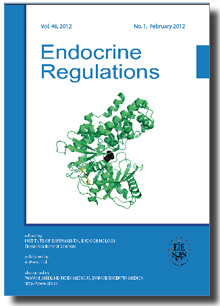Endocrine Regulations Vol.37, p.211-224, 2003
|
| Title: THE RELATIONSHIP BETWEEN BONE METABOLISM, MELATONIN AND OTHER HORMONES IN SHAM-OPERATED AND PINEALECTOMIZED RATS |
| Author: Z. Ostrowska, B. Kos-Kudla, M. Nowak, E. Swietochowska, B. Marek, J. Gorski, D. Kajdaniuk, K. Wolkowska |
|
Abstract: Objective. The influence of pinealectomy and long-term melatonin (MEL) administration on circadian oscillations of selected biochemical markers of bone metabolism [serum alkaline phosphatase (ALP) activity, carboxyterminal propeptide type I procollagen (PICP) and carboxyterminal telopeptide type I collagen (ICTP) concentrations as well as urinary excretion of hydroxyproline (HYP) and Ca] and possible involvement of circadian secretion of IGF-I, parathyroid, thyroid, adrenal cortex and gonads function in this mechanism was evaluated.
Methods. Studies were performed in 192 adult male Wistar rats weighing 145±9 g which were subjected to pinealectomy or sham operation. In half of the animals from each group MEL (Sigma, USA) in a dose of 50 mg/100 g b.w. was administered intraperitonealy (daily between 17.00 and 18.00 h for a 4-week period). Material for studies (blood and urine) was collected every 3 hours during a day. Hormones, PICP and ICTP concentrations were determined with the use of RIA methods, whereas ALP, HYP and Ca values - spectrophotometrically.
Results. The study has shown that pinealectomy had an inducing, while exogenous MEL a suppressing effect upon the level of investigated biochemical markers of bone metabolism. Furthermore, substantial changes in the values of amplitude and phase of their circadian oscillations were shown. Distinct, dependent on the time of day disturbances in circadian fluctuations of PICP, ICTP, HYP and Ca showing generally negative correlation with changes in endogenous MEL concentrations and positive with IGF-I and corticosterone (B) levels were found. In addition, changes in circadian oscillations of ALP and PICP correlated negatively with daily oscillations of calciotropic hormones and B. However, ICTP, HYP and Ca concentrations correlated positively with circadian fluctuations of B and FT3 (the latter only in sham operated rats receiving MEL).
Conclusions. This study showed that both pinealectomy and long-term MEL administration influence the circadian rhythm of bone metabolism and that an important role in the mechanism of this dependence is played by the changes of endogenous MEL levels. Secondary changes in circadian oscillations of calciotropic hormones, IGF-I and corticosterone concentrations, caused by pinealectomy and long-term MEL administration result in altered bone metabolism rhythm.
|
|
| Keywords: Pinealectomy – Melatonin – Bone metabolism – Hormones – Circadian rhythm –- Male rats |
|
|
|
| Year: 2003, Volume: 37, Issue: |
Page From: 211, Page To: 224 |
|
Price:
25.20 €
|
|
|
|
|
|
|
|

